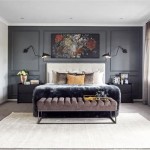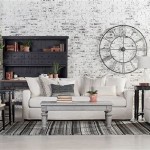```html
Minimalist Home Decor: A Comprehensive Guide
Minimalist home decor is a design philosophy centered on simplicity, functionality, and the conscious curation of possessions. It transcends mere aesthetics, becoming a lifestyle choice that promotes clarity, focus, and a sense of calm within the living space. The practice encourages individuals to declutter, prioritize quality over quantity, and create environments that are both visually appealing and conducive to well-being. This approach moves away from the accumulation of unnecessary items and embraces the concept of intentional living within a carefully designed space.
The roots of minimalism can be traced back to various artistic and philosophical movements, including modernism, Bauhaus, and Zen Buddhism. These influences emphasize clean lines, functional design, and the appreciation of empty space. Minimalist home decor draws inspiration from these principles, seeking to eliminate distractions and create a peaceful environment that reflects the individual's core values. The goal is not to achieve a sterile or impersonal space, but rather to cultivate a sense of serenity and order through thoughtful design choices.
Key Principles of Minimalist Home Decor
Several key principles guide the implementation of minimalist home decor. These principles serve as a framework for making informed decisions about furniture, accessories, and overall design choices, ensuring a cohesive and intentional aesthetic.
Functionality: Every item within the minimalist home should serve a purpose. Decorative objects are carefully selected for their aesthetic appeal and their ability to enhance the functionality of the space. Furniture pieces are chosen for their comfort and durability, as well as their ability to seamlessly integrate into the overall design. The emphasis is on practicality and efficiency, avoiding items that simply take up space without adding value to the living experience.
Simplicity: Embracing simplicity is central to minimalist design. This involves reducing visual clutter, using a limited color palette, and opting for clean lines and geometric shapes. Ornamentation is kept to a minimum, with a focus on showcasing the inherent beauty of materials and forms. The goal is to create a visually calming environment that allows the eye to rest and the mind to focus.
Quality over Quantity: Minimalist home decor prioritizes investing in high-quality, durable items that will last for years to come. This approach encourages a more sustainable lifestyle by reducing the need for frequent replacements. Choosing well-crafted furniture, textiles, and accessories not only enhances the aesthetic appeal of the space but also contributes to a sense of enduring quality and value. This principle also translates to fewer items in general, embracing the idea of less being more.
Intentionality: Every item that enters the minimalist home is carefully considered and chosen with intention. This involves asking questions such as: "Does this item serve a purpose?" "Do I truly love this item?" "Does this item contribute to the overall aesthetic of the space?" By being mindful of possessions, individuals can create a home that reflects their values and priorities.
Open Space: Empty space is just as important as the objects within the minimalist home. Open areas allow for ease of movement, promote a sense of calm, and create visual breathing room. Avoiding overcrowding furniture and accessories allows the individual to move freely and experience a sense of spaciousness. The strategic use of empty space contributes to the overall feeling of tranquility and order.
Implementing Minimalist Home Decor in Different Rooms
The principles of minimalist home decor can be applied to various rooms within the home, creating a cohesive and harmonious aesthetic throughout the entire living space. Each room presents unique challenges and opportunities for implementing minimalist design principles.
Living Room: The living room is often the focal point of the home, and therefore, it is essential to create a welcoming and uncluttered space. Opt for a comfortable sofa in a neutral color, paired with a few well-chosen accent chairs. A simple coffee table with clean lines and a minimalist rug can complete the seating area. Wall decor should be kept to a minimum, with a focus on a few statement pieces like a piece of art or a large mirror. Storage solutions, such as built-in shelving or a console table with closed storage, can help to keep clutter at bay.
Bedroom: The bedroom should be a sanctuary for rest and relaxation. A minimalist bedroom should prioritize comfort and simplicity. A comfortable bed with high-quality linens in neutral colors is essential. A simple nightstand with a lamp and a few personal items can provide a touch of personalization. Avoid cluttering the walls with excessive pictures or decorations. Opt for a few carefully chosen pieces of art or a large mirror to create a sense of spaciousness. Adequate storage, such as a dresser or closet organizers, is crucial for keeping the bedroom tidy and clutter-free.
Kitchen: A minimalist kitchen is both functional and aesthetically pleasing. Declutter countertops by storing appliances and utensils in cabinets and drawers. Opt for simple, clean lines in cabinetry and hardware. A neutral color palette can create a sense of calm and serenity. Open shelving can be used to display a few carefully chosen items, such as cookbooks or glassware. Invest in high-quality kitchen tools and appliances that will last for years to come. Keep the backsplash simple and uncluttered, opting for a solid color or a subtle pattern.
Bathroom: The bathroom should be a spa-like retreat, free from clutter and distractions. Opt for a simple vanity with ample storage. A minimalist shower curtain or glass enclosure can create a sleek and modern look. Use neutral colors on the walls and floors to create a sense of calm. Keep countertops clear of clutter by storing toiletries in drawers or cabinets. A few carefully chosen accessories, such as a plant or a scented candle, can add a touch of warmth and personality.
Choosing Colors and Materials for Minimalist Home Decor
The selection of colors and materials is crucial for achieving a minimalist aesthetic. A carefully curated palette can create a sense of harmony and tranquility, while thoughtful material choices can add texture and visual interest to the space.
Color Palette: Minimalist home decor typically utilizes a neutral color palette, such as white, gray, beige, and black. These colors create a sense of calm and serenity, allowing the eye to rest and the mind to focus. Accent colors can be used sparingly to add pops of visual interest, but it is important to keep the overall color scheme consistent and cohesive. Natural tones derived from wood, stone and organic fibers also fit well, contributing to the earthiness common in minimal design.
Materials: Natural materials, such as wood, stone, and linen, are often used in minimalist home decor to add texture and warmth to the space. These materials have an inherent beauty that complements the minimalist aesthetic. Metal accents, such as stainless steel or brass, can add a touch of sophistication and elegance. Textiles, such as wool and cotton, can be used to create a cozy and inviting atmosphere. The materials chosen should reflect the overall aesthetic of the space and contribute to its functionality and durability.
Lighting: Lighting plays a crucial role in minimalist home decor. Natural light is highly valued, as it creates a sense of openness and airiness. Strategic placement of windows and skylights can maximize natural light exposure. Artificial lighting should be simple and functional, with a focus on task lighting and ambient lighting. Recessed lighting, track lighting, and pendant lights are all popular choices for minimalist homes. The lighting should be warm and inviting, creating a comfortable and relaxing atmosphere. Dimmable lighting is also useful for creating ambiance.
By embracing these principles and incorporating them into design choices, individuals can create a minimalist home that is both beautiful and functional. This creates a space that is conducive to well-being and reflects their personal values.
```:strip_icc()/af1be3_3075c14ccd2b461aaa9f8b3bc4e1c5e3_mv2-56f748ca98b44c8b861fa0a01d5bc504.jpeg?strip=all)
8 Ways To Embrace Minimalist Interior Design At Home

30 Minimalist Living Room Ideas
:max_bytes(150000):strip_icc()/ScreenShot2022-12-14at2.46.36PM-bb837b67e0884152959f525b6e426c67.png?strip=all)
17 Minimalist Decorating Ideas For A Calm And Clean Space

11 Minimalist Home Design Tips And Ideas Designcafe

Minimalist Home Decor The Depot

9 Ways To Minimalist Decor That Will Make Your Home Clutter Free

Everything You Need To Know About Minimalist Design

10 Ways To Make A Minimalist Home Feel Warm And Cozy Decoholic

How To Turn Your Home Décor Into A Minimalist One

34 Modern Minimalist Living Rooms Designer Examples Tips
Related Posts







